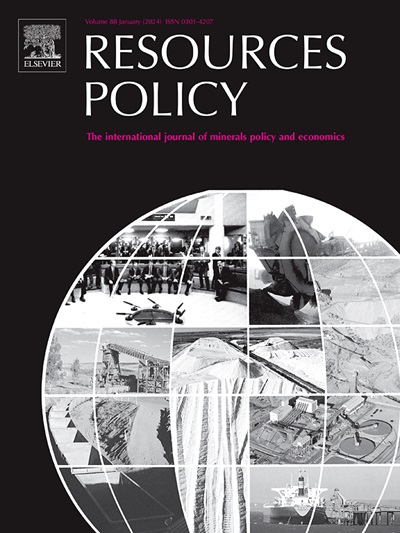Reducing density uncertainty in iron ore deposits: Taking advantage of the density and Fe grades correlation aiming to more accurate models
IF 10.2
2区 经济学
0 ENVIRONMENTAL STUDIES
引用次数: 0
Abstract
This study addresses the critical role of density in the economic evaluation of mineral deposits and how uncertain could be the density models without considering the available secondary information. Most mining companies subjectively determine sample quantity and spatial distribution for density estimation. Usually, the density samples are sparser than the grade samples. Fewer samples tend to generate higher uncertainty as less information is available. Although the density has fewer samples, it is correlated positively with iron grades in an iron deposit. However, this correlation between density and grade is not considered to generate density models. In this context, this research aims to reduce the uncertainty associated with density in iron ore deposits by exploring the correlation between grades and density, using this information to create density models. Therefore, the iron grade was used as an auxiliary variable to create density models proposing different multivariate geostatistical techniques. Two cosimulation approaches were proposed. The first one uses simple cokriging to incorporate the auxiliary variable, while the second uses intrinsic collocated cokriging. These two approaches were compared against univariate geostatistical simulation, which ignores the correlation between density and grades. The results demonstrated the effectiveness of incorporating iron grades in density models, observing histogram matching, reproduction of spatial continuity, the possibility of using the E-Type as estimated models, conditional standard deviation reduction and better accuracy plots in ore and waste domains. Also, a mass analysis was performed in ore domains, making evident how consider Fe grades could change what to expect in future. The study concludes that leveraging iron grades significantly reduces uncertainty in density models, providing accurate and reliable models and proposing methodologies that could be extrapolated to estimates, being viable to create density estimated models for more effective mining planning and resource management in iron deposits.
减少铁矿床密度的不确定性:利用密度和铁品位的相关性,旨在建立更准确的模型
本研究探讨了密度在矿床经济评价中的关键作用,以及如果不考虑现有的二次信息,密度模型的不确定性有多大。大多数矿业公司主观地确定样本数量和空间分布进行密度估计。通常,密度样品比品位样品更稀疏。较少的样本往往会产生较高的不确定性,因为可用的信息较少。在铁矿床中,虽然密度样品较少,但密度与铁品位呈正相关。然而,密度和品位之间的这种相关性并没有被认为可以产生密度模型。在此背景下,本研究旨在通过探索品位和密度之间的相关性来减少与铁矿床密度相关的不确定性,并利用这些信息创建密度模型。因此,铁品位被用作辅助变量来创建密度模型,提出了不同的多元地质统计技术。提出了两种协同模拟方法。第一种方法使用简单的协克里格法来合并辅助变量,而第二种方法使用内在并置协克里格法。将这两种方法与忽略密度和品位相关性的单变量地质统计模拟进行了比较。结果表明,将铁品位纳入密度模型的有效性,观察直方图匹配,再现空间连续性,使用e型作为估计模型的可能性,条件标准差降低以及在矿石和废物领域获得更好的精度图。此外,在矿石域进行了质量分析,表明考虑铁品位如何改变未来的预期。该研究的结论是,利用铁品位显著降低了密度模型的不确定性,提供了准确可靠的模型,并提出了可以外推到估计的方法,可以为更有效的铁矿开采规划和资源管理创建密度估计模型。
本文章由计算机程序翻译,如有差异,请以英文原文为准。
求助全文
约1分钟内获得全文
求助全文
来源期刊

Resources Policy
ENVIRONMENTAL STUDIES-
CiteScore
13.40
自引率
23.50%
发文量
602
审稿时长
69 days
期刊介绍:
Resources Policy is an international journal focused on the economics and policy aspects of mineral and fossil fuel extraction, production, and utilization. It targets individuals in academia, government, and industry. The journal seeks original research submissions analyzing public policy, economics, social science, geography, and finance in the fields of mining, non-fuel minerals, energy minerals, fossil fuels, and metals. Mineral economics topics covered include mineral market analysis, price analysis, project evaluation, mining and sustainable development, mineral resource rents, resource curse, mineral wealth and corruption, mineral taxation and regulation, strategic minerals and their supply, and the impact of mineral development on local communities and indigenous populations. The journal specifically excludes papers with agriculture, forestry, or fisheries as their primary focus.
 求助内容:
求助内容: 应助结果提醒方式:
应助结果提醒方式:


